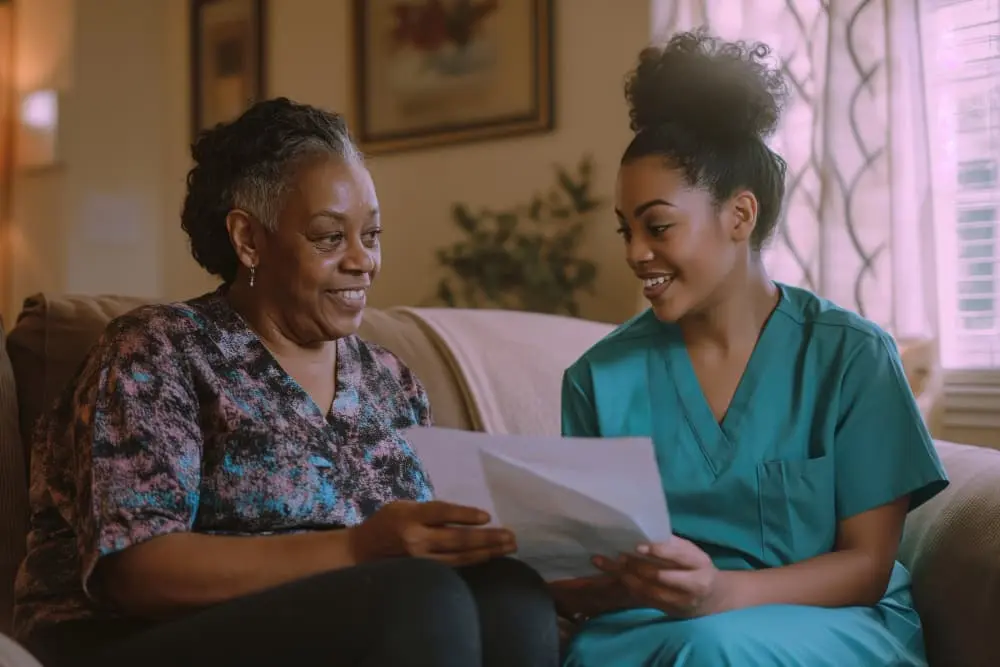Home Health Care: Caring for a loved one at home can be rewarding, but it also comes with challenges. One of the most important things you can do is create a safe and comfortable environment. With a few adjustments, you can reduce risks and ensure they feel secure and at ease.
Assess the Home for Safety Hazards
When it comes to safety, it’s all about minimizing the risk of accidents. I remember when my mother first came home after surgery—it hit me how something as simple as a throw rug could turn into a dangerous tripping hazard. Start by taking a fresh look at the home:
- Remove clutter from hallways and walkways.
- Install grab bars in the bathroom for extra support, especially near the toilet and shower.
- Use non-slip mats in areas prone to water like the bathroom or kitchen.
Even small changes like these can make a huge difference.
Proper Lighting and Accessibility
Good lighting is a game-changer, especially for those with impaired vision. Dim hallways or shadowy staircases increase the chances of a fall. Brighten up the space:
- Install nightlights in bedrooms, bathrooms, and hallways so your loved one can safely navigate at night.
- Consider motion-sensor lights for added convenience.
- If they use a walker or wheelchair, ensure there’s enough room to move around comfortably—widen doorways if necessary.
Clear, well-lit spaces are essential for their safety.
Comfortable Furniture and Mobility Aids
Comfort goes beyond just soft cushions. The right furniture can help your loved one maintain their independence and dignity. It’s all about ease of movement:
- Choose a bed that’s the right height for them to easily get in and out of, or invest in an adjustable one.
- Add comfortable chairs that are easy to sit in without sinking too low or too high to stand up from.
- Ensure there’s space for mobility aids like walkers or wheelchairs. You don’t want them feeling stuck in their own home.
I’ve seen how even small tweaks in furniture can restore a sense of freedom.
Personalizing the Space for Comfort
Home isn’t just a place—it’s a feeling. Make the space inviting. I often find that personal touches help bring a sense of comfort:
- Surround them with familiar items like family photos, cherished keepsakes, or even their favorite blanket.
- Keep things they love in view, whether that’s a favorite book, flowers, or their favorite chair by the window.
- For loved ones with memory issues, familiar objects can make them feel secure and reduce anxiety.
A familiar, personalized environment makes a big difference, especially for someone who’s adjusting to needing more care.
Temperature Control and Air Quality
Comfort isn’t just about appearance—it’s about how a space feels. Imagine being cold all the time or having difficulty breathing in your own home. That’s why maintaining the right temperature and air quality is key:
- Keep the home at a comfortable temperature—not too hot, not too cold. Consider adding fans or heaters depending on the season.
- Ensure good air circulation by regularly airing out rooms and using air purifiers, especially if allergies are a concern.
Establishing a Routine and Quiet Environment
Routine brings peace. It’s something predictable in a world that can feel overwhelming. Keep daily activities structured:
- Establish a consistent daily routine for meals, medication, and rest. Knowing what’s coming next can be calming.
- Keep the environment quiet and peaceful, especially during rest times. Loud noises or sudden disruptions can be distressing.
I’ve seen how this routine becomes something to lean on, not just for the patient, but for everyone involved.
Adapting for Specific Home Health Care
No two people’s care needs are the same. If your loved one has a specific health condition, their home should reflect that:
- Install ramps or stair lifts for easier movement for those with limited mobility.
- If they have cognitive issues, like dementia, secure hazardous materials and consider simple labeling to guide them around the house.
It’s about making the home work for their specific needs, so they feel safe and cared for.
Emergency Preparedness
Preparing for emergencies isn’t optional—it’s essential. Make sure your loved one knows what to do in case of a fire or medical emergency:
- Keep a first aid kit and emergency numbers within easy reach.
- Ensure the home has working smoke detectors and carbon monoxide alarms.
- Ensure emergency exits are clear, and discuss a plan so everyone knows what to do if something happens.
You can’t always predict emergencies, but you can be prepared.
Conclusion
Home Health Care: Creating a safe and comfortable environment for home health care is an ongoing process. It requires attention to detail, a little creativity, and a whole lot of love. By assessing the home for hazards, making it more accessible, and adding personal touches, you can create a space that keeps your loved one safe and helps them feel at ease.
Take a moment and think—what small changes can you












